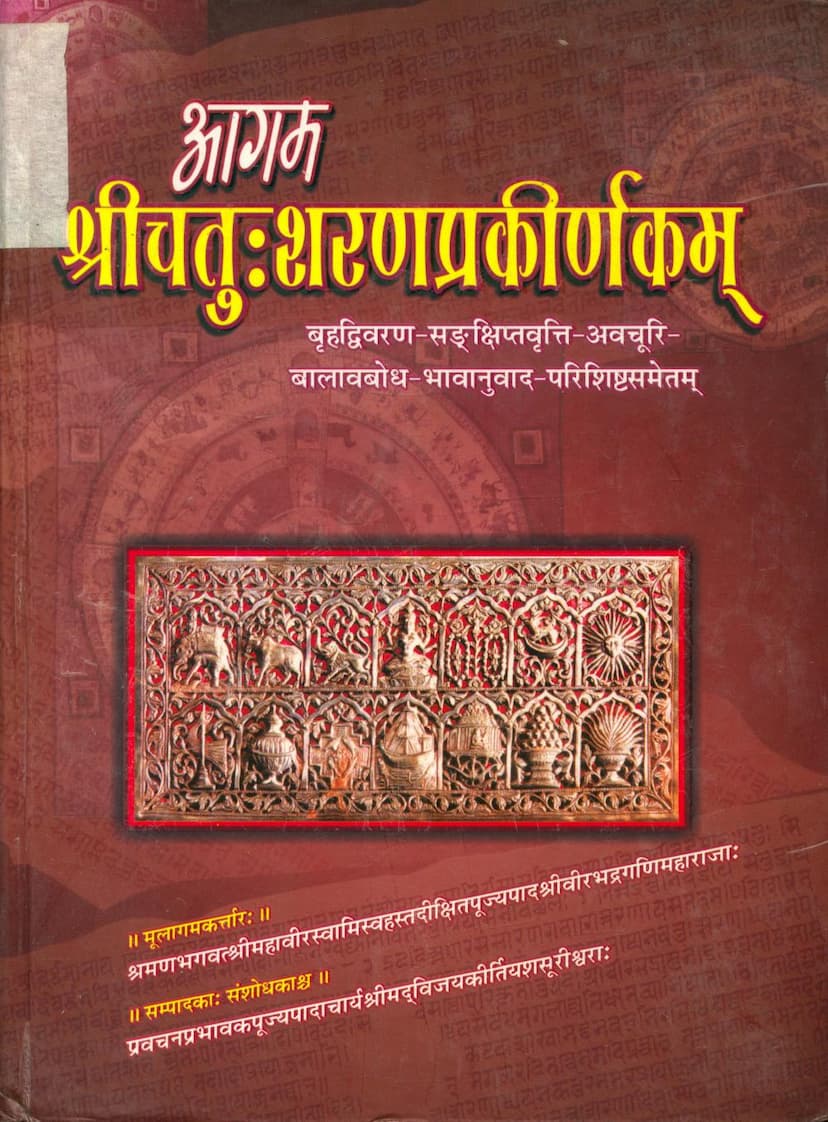Agam Chatusharan Prakirnakam
Added to library: September 1, 2025

Summary
This Jain text, titled Agam Chatusharan Prakirnakam, authored by Kirtiyashsuri, and published by Sanmarg Prakashan, is a significant work within Jain literature. The provided catalog link and the extensive text offer a deep dive into its contents and commentaries.
Here's a comprehensive summary in English, based on the provided text:
Core Text:
- Title: Agam Chatusharan Prakirnakam (आगम श्रीचतुःशरणप्रकीर्णकम्)
- Author of the Root Text (Moolagam): Shraman Bhagwat Shrimahavir Swami's direct disciple, Pujyapada Shri Virabhadra Gan Maharaj (श्रमण भगवत् श्रीमहावीर स्वामिस्वहस्तदीक्षित पूज्यपाद श्रीवीरभद्रगणिमहाराजाः).
- Original Name: While commonly known as Chatusharan Prakirnakam, its original name is "Kushalanubandhi Adhyayan" (कुशलानुबंधी अध्ययन).
- Subject Matter: The core text, comprising 63 gathas in Prakrit language, focuses on guidance for spiritual practice (sadhana). It aims to guide practitioners towards successful meditation (samadhi) and a bright end-of-life, emphasizing the importance of samadhi for achieving liberation (moksha). It illustrates the profound principles of spiritual discipline, particularly the 'four refuges' (chatuh sharan), 'condemnation of misdeeds' (dushkrit garha), and 'approval of good deeds' (sukrit anumodana).
Commentaries and Supporting Literature:
The text is presented with multiple layers of commentary, making it a rich resource for scholars and practitioners:
- Brihad Vivaran (बृहद्विवरण): An extensive commentary by an unknown author (अज्ञातकर्तृक). It meticulously explains the core text's philosophy and concepts, drawing upon the works of previous acharyas. The date of its composition is estimated to be around the 14th century.
- Avachuri (अवचूरि): A commentary by Tapagachhadhipati Pujyapada Acharya Shri Som Sundar Suri (तपागच्छपुरन्दर पूज्यपादाचार्यश्रीमद्विजयसोमसुन्दरसूरीश्वराः).
- Sankshipt Vrittti (सङ्क्षिप्तवृत्ति): A concise commentary by Tarkiratna Acharya Pujyapada Acharya Shri Vijay Gunaratna Suri (तार्किकरत्नाचार्यपूज्यपादाचार्यश्रीमद्विजयगुणरत्नसूरीश्वराः).
- Balavabodha (बालावबोध): An explanatory text written in Gujarati by Pujyapada Mahamahopadhyay Shri Vinay Vijay Ganivarya (पूज्यपाद महामहोपाध्याय श्रीविनयविजयगणिवर्याः). This provides a simplified explanation for a wider audience.
Compilation and Editorship:
The current publication is a result of meticulous research and compilation.
- Editors and Refiners: Pujyapada Acharya Shri Vijay Kirtiyash Suri (तपागच्छाधिपतिपूज्यपादाचार्यश्रीमद्विजयरामचन्द्रसूरीश्वराणां पट्टप्रभावकवर्धमानतपोनिधिपूज्यपादाचार्यश्रीमद्विजयगुणयशसूरीश्वराणां चरणचञ्चरीकाः प्रवचनप्रभावकपूज्यपादाचार्यश्रीमद्विजयकीर्तियशसूरीश्वराः). The compilation is dedicated to the memory of Pujya Acharya Shri Vijay Ramchandra Suri.
Key Themes and Teachings:
- The Four Refuges (Chatuh Sharana): The central concept revolves around seeking refuge in the four essential entities of Jainism:
- Arihant (अरहंत): The liberated souls who have destroyed all karmas and attained omniscience.
- Siddha (सिद्ध): The souls who have achieved eternal liberation and reside in the Siddhashila.
- Sadhu (साधु): Ascetics who follow the path of righteousness and practice the highest virtues.
- Dharma (धर्म): The path of righteousness as taught by the Tirthankaras, characterized by non-violence, truth, non-stealing, celibacy, and non-possession.
- Samadhi and Spiritual Progress: The text emphasizes that true spiritual progress (sadhana) leads to samadhi (equanimity and deep concentration), which is essential for liberation.
- The Importance of Six Avasyakas: The text highlights the significance of the six essential daily duties (shadavashyak) in Jain practice – Samayika (equanimity), Stuti (praise of Tirthankaras), Vandana (salutation), Pratikraman (repentance), Kayotsarg (body abandonment/meditation), and Pratyakhyan (vow/renunciation). The understanding and practice of these are intrinsically linked to the four refuges.
- Moral Conduct: The text strongly advocates for righteous living, including the condemnation of misdeeds (dushkrit garha) and the approval of virtuous actions (sukrit anumodana). It details various ethical principles and their importance in spiritual advancement.
- Overcoming Obstacles: The teachings focus on overcoming obstacles in the spiritual path, such as attachment to worldly pleasures, aversion to difficulties, the cycle of birth and death (samsara), and the impact of negative emotions like attachment (raag) and aversion (dvesh).
- The Creator of the Root Text: The author of the root text, Shri Virabhadra Gan Maharaj, was a direct disciple of Lord Mahavir Swami, underscoring the authenticity and authority of the teachings.
Structure and Content:
The book is structured into several volumes, indicating the comprehensive nature of this compilation:
- Khanda - 1: Contains the root text (Chatuhsharana Prakirnakam) along with the Brihad Vivaran (by an unknown author).
- Khanda - 2: Presents the Avachuri by Acharya Som Sundar Suri and the Vrittti by Acharya Gunaratna Suri.
- Khanda - 3: Includes various appendices (Parishishta) such as commentaries, translations, indices, and critical reviews, enhancing the scholarly value of the work.
Overall Significance:
The Agam Chatusharan Prakirnakam, with its multiple commentaries and appendices, serves as a profound guide for Jain ascetics and lay followers aiming for spiritual purification and ultimate liberation. It meticulously details the path of spiritual discipline through the core principles of the four refuges, righteous conduct, and the cultivation of inner peace and equanimity. The publication signifies a significant effort in preserving and disseminating these valuable Jain teachings.